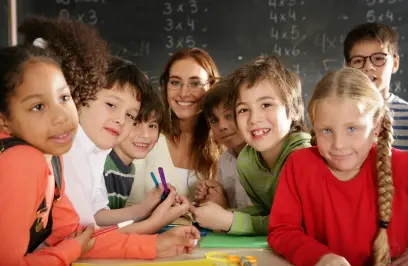Child Development Guide for School Age Children

Children develop at their own pace, so it's impossible
to tell exactly when yours will learn a given skill. The
developmental milestones below will give you a general
idea of the changes you can expect as your child gets
older, but don't be alarmed if your child progress is not exactly like listed.
different course.
Child Development by Age 5 years (60 months)
Social Skills
- Wants to please friends
- Wants to be like her friends
- More likely to agree to rules
- Likes to sing, dance, and act
- Shows more independence and may even visit a next-door neighbor by herself
Emotional Development
- Aware of gender
- Able to distinguish fantasy from reality
- Sometimes demanding, sometimes eagerly cooperative
Cognitive Development
- Can count 10 or more objects
- Correctly names at least four colors
- Better understands the concept of time
- Knows about things used every day in the home (money, food, appliances)
Language skills
- Recalls part of a story
- Speaks sentences of more than five words
- Uses future tense
- Tells longer stories
- Says name and address
Movement
- Stands on one foot for 10 seconds or longer
- Hops, somersaults
- Swings, climbs
- May be able to skip
Hand and Finger Skills
- Copies triangle and other shapes
- Draws person with body
- Prints some letters
- Dresses and undresses without help
- Uses fork, spoon, and (sometimes) a table knife
- Usually cares for own toilet needs
Health Watch
Tell your child's doctor or nurse if your child displays any
of the following signs of possible developmental delay for
this age range.
- Acts extremely fearful or timid
- Acts extremely aggressively
- Is unable to separate from parents without major protest
- Is easily distracted and unable to concentrate on any single activity for more than five minutes
- Shows little interest in playing with other children
- Refuses to respond to people in general, or responds only superficially
- Rarely uses fantasy or imitation in play
- Seems unhappy or sad much of the time
- Doesn't engage in a variety of activities
- Avoids or seems aloof with other children and adults
- Doesn't express a wide range of emotions
- Has trouble eating, sleeping, or using the toilet
- Can't tell the difference between fantasy and reality
- Seems unusually passive
- Cannot understand two-part commands using prepositions ("Put the doll on the bed, and get the ball under the couch.")
- Can't correctly give her first and last name
- Doesn't use plurals or past tense properly when speaking
- Doesn't talk about her daily activities and experiences
- Cannot build a tower of six to eight blocks
- Seems uncomfortable holding a crayon
- Has trouble taking off clothing
- Cannot brush her teeth efficiently
- Cannot wash and dry her hands
Sources:The Partnership for Reading
Bringing Scientific Evidence to Learning
National Institute for Literacy
National Institute of child Health and Human Development
U.S. Department of Education